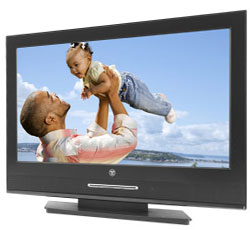
Dick De Jong
October 7, 2008
HDTV Solutions
The feature that sets the Westinghouse VK-40F580D apart from the vast majority of other 1080p LCDs in the marketplace is tucked in under its screen. Nestled between the TV's 10W speakers lies a built-in front-loading DVD player.
I am usually not a fan of multi-component electronics because one piece usually flakes out before the other. Those TV/VCR combinations come to mind.
But I cannot deny the convenience of not having a separate DVD player with its cables that need to be stowed away. Especially if you plan to hang the TV on the wall, this HDTV/DVD Combo saves you the hassle of hiding wires.
Another factor in judging a pairing like this is how well the components are matched. In this case, the standard definition DVD player, which is part of the package, cannot output a high enough quality video signal to do justice to the high definition LCD TV.
This quite respectable 1080p display really deserves a Blu-ray player as a counterpart. I realize that substituting a Blu-ray component would have raised the price, but the union would have been more compelling for videophiles.
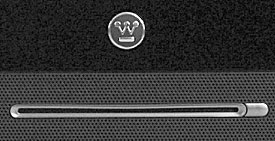
With its almost two inch standard glossy black bezel, the only distinguishing mark on the face of the VK-40F580D is the slit below the Westinghouse "W" logo where you feed discs into this front-loading DVD player.
Next to the slot is the eject button. The surrounding speaker grille opts for a matte black grid texture.
Westinghouse has applied their DayBright anti-glare coating to the screen, which almost eliminates distracting reflections.
If you look from the side, you'll see that this 49 pound TV (with its non-swivel stand) bumps out at the bottom to allow room for the DVD player. Without the stand, the unit is almost seven inches deep.
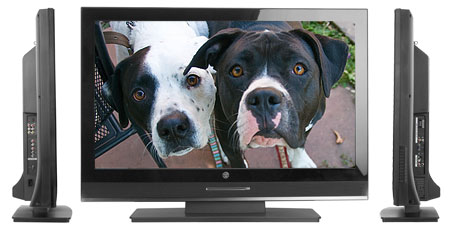
Also, you will see their Spline design for locating the connections. On the left side are one Component input (YPbPr) with matching stereo Audio Ins, two Composite (with Audio), a USB port, and an antenna input.
On the opposite side are two HDMI inputs, (one with matching stereo Audio Ins), one VGA (15 pin D-Sub) with a minijack Audio In, a digital SPDIF Audio Out (optical), a stereo analog Audio Out and a subwoofer out.
The one RF antenna input connects to integrated NTSC/ATSC/QAM tuners. Since the tuner system is Clear QAM compatible, you can attach your cable TV signal directly into the RF connector and tune in unscrambled cable stations.
For those concerned about the DTV transition coming up, the ATSC tuner is the key. With it you will be able to tune in digital signals broadcast over the air.
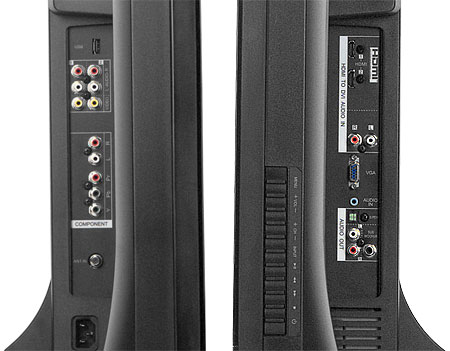
Left & Right Side of the VK-40F580D
Notice that an S-Video input is not furnished, which I don't mourn. I would prefer at least one more HDMI input. I assume the designers thought that with an integrated DVD player, they could economize with two HDMIs.
What I do applaud is the addition of the USB port that accepts downloads of JPEG images from digital still cameras or flash drives. I'm beginning to consider this ability more of a necessity and less of a luxury for HDTVs.
The Photo Viewer interface is fundamental but functional. You can set playback times, though you have only two choices, fast and slow. You can't rearrange the slide order. It's only newest to oldest or vice versa. There are no transitions, such as fades or wipes. And an annoying message pops up over the current slide that tells you the loading progress of the next image.
I can forgive some of those shortcomings because you can adjust the Photo Viewer picture using the full set of Picture controls. This capability is essential for an avid photographer who wants to present his or her work in the best light.

Missing from the TV, no Ethernet port is supplied for connecting to the Internet or your home computer network. Also, no picture-in-picture feature is included.
I am impressed with the logic and thought that is evident in the initial setup of the TV and its menus. Therefore, I was surprised that the manual was rife with broken English and typos. American English is too idiosyncratic to outsource manuals. Also, the User's Manual, which is just for this HDTV/DVD combo unit, does not contain any mention of operating the DVD player.
Luckily, the non-backlit remote control is laid out fairly well with separate buttons for running the DVD player. Though I would have made a couple of changes. The Mute button should be next to the Volume rocker and the DVD Eject button should be located next to the other DVD controls.
Our process of measuring the power consumption of our review units is straightforward. We plug the TV into a watt meter, called Watts up? Pro, and take a simple sampling of readings during the playback of a full screen video clip.
The first measurement is at the TV's default picture settings, which are often some form of Vivid. Interestingly, Westinghouse appropriately labels this Picture Mode as Showroom, as in, only use this if you own a big box store. Our reading for Showroom ranged between 265 and 275W. The manual states Power Consumption as under 300W.
We also take a reading after we adjust the picture to our preference, which is a much less bright image than Showroom. The power consumption lowered to 124 to 127W. Of course, depending on how you like to set up your TV, your mileage may vary.
Finally, we turn off the TV and measure how much power it is using. The VK-40F580D offers two standby settings, Normal and Energy Saving, the difference is in how quickly the TV powers up from Off.
In Normal, the meter stabilizes at about 23.5W. (The manual states less than 30W.) When you turn on the TV from Normal, the picture is displayed in about two seconds.
In Energy Saving mode, the standby consumption is around 4W. (The manual says less than 5W.) The start up time from Energy Saving was about 7 to 8 seconds, which for me, is definitely acceptable for the 19W savings. (The manual writes that it takes about 15 to 20 seconds, which was not my experience.)
Usually in our basic setup procedure to calibrate the monitor, we use the Blu-ray version of the Digital Video Essentials DVD called HD Basics. We play the DVD on a Pioneer BDP-94HD Blu-ray player connected to the HDTV with an HDMI cable.
Since the VK-40F580D has a built-in DVD player, we reverted back to our old standard definition version DVD of Digital Video Essentials.
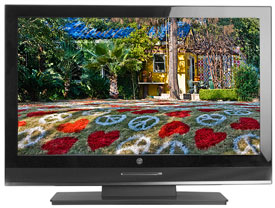
Setup was a breeze. I began by picking Custom from the five Picture Mode choices. (The others are Showroom, Game, Movie, and Sports.) And I turned the Backlight to 25, down from the max of 50.
Reducing the Backlight is a personal preference which I can afford because our viewing room has subdued lighting. But if you have the option, lowering the Backlight also can significantly cut power consumption.
I also prefer a neutral color bias. So you can guess which of the three Color Temperatures, Cool, Neutral or Warm, that I picked.
I then used the DVD's test patterns to adjust black level, white level, and color bias. I boosted Brightness a notch, fine tuned Contrast and set Sharpness to 0. The default settings for Saturation (Color) and Hue (Tint) were right on.
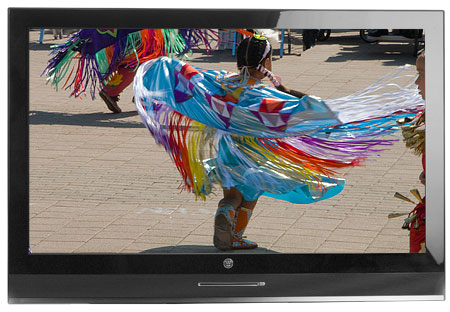
I didn't need to do any more tweaking, which is fortunate because this HDTV doesn't have an extensive set of advanced controls. A Calibration sub-menu provides Dynamic Contrast and Color Stretch. It also has a Custom Color Temperature setting with sliders for Red, Green, and Blue Gain. But with HDMI signals or a direct feed from the onboard DVD player, that setting is deactivated.
I decided to load up the Blu-ray version of the Digital Video Essentials DVD into the Pioneer Blu-ray player. Each input has its own picture adjustment settings. With this HDMI source, my setup was very similar with close to the same settings. Both times, I was very satisfied with the resulting picture quality.
HDTV manufacturers are becoming very adept at building 1080p displays that deliver luscious, sharp, gratifying images. Westinghouse Digital and its VK-40F580D fit that mold.
As usual, the best performance occurs when feeding the TV high definition material, especially Blu-rays or HD DVDs. For example, the new Iron Man Blu-ray is riveting.
Black levels are not deep. I tended to drop Brightness a notch or two below my original calibration levels and that helped add a little dark oomph.
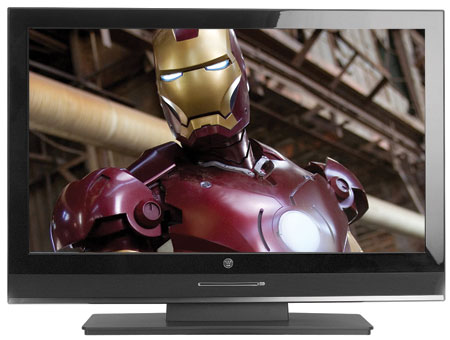
The VK-40F580D does not perform miracles with standard definition material. SD programs coming through an antenna just can't hold a candle to HD content, but that is really more a problem with the source and not the TV.
I had hoped to see better results in the playback of SD DVDs from the integrated DVD player. Westinghouse touts their Pixel Direct technology that "delivers DVD video to the screen using a direct path and the least amount of signal processing."
The theory seems valid, a direct connection of DVD signal to HDTV source with no cables. In fact, the incoming signal is 480i and the TV upscales it to 1080p. I have no problem with the concept. It's just that I was expecting that the execution would be better.
It seems my optimism was a bit unrealistic. And looking back at previous experiences with upscaling gnarly SD content, I realize that only so much can be done. That is why I wish that Westinghouse had bit the bullet and upgraded to a Blu-ray player.
I connected my laptop through the VGA Out to the TV's VGA In. I was able to set the computer's video output to 1920 x 1280.
I changed the Picture Mode on the TV to Custom from the default of Game and then lowered the Backlight. Images in Photoshop looked outstanding. Internet pages were easily readable from a distance.
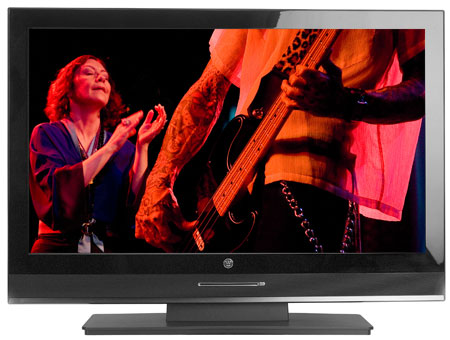
The audio quality from those tiny 10W integrated front firing speakers was as good as could be expected. Just don't expect much. To be fair, the audio is not bad and more than adequate for basic TV listening.
But it reaches its limitations pretty quickly. I could pump the volume beyond my ears' comfort level and also past the speakers' ability to maintain undistorted output.
The Audio Menu does provide an Equalizer with presets named Classical, Pop, Rock, Disco, and Flat, but you do not have the ability to tweak those settings. Also, there is not a Surround Sound mode.
Buried in the Calibration sub-menu along with picture adjustments is a feature called Level Set, which "smooths out the sound when changing channels and sources." I didn't give it a real scientific testing, but the volume does lower just by turning On Level Set. For that reason alone, I turned it Off.
The Westinghouse VK-40F580D combines a very good high definition TV with a so-so standard definition DVD player. If you have a collection of SD DVDs, the convenience of an all-in-one package is appealing. But if you want to see this HDTV really shine, hook it up to a Blu-ray player.
Posted Mar 14, 2014 10:48:17 PM
By Margaret